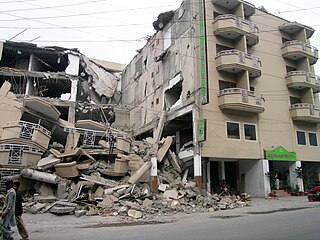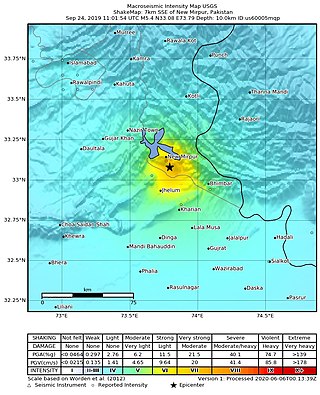Related Research Articles

Chumb is an area in the southern tip of Azad Kashmir, Pakistan. The Chumb sector consists of many villages, Kherowal, Burejal, Nagial, Paur, Dingawali, Chak Pandit, Praganwala, Jhanda, Singry, Sardari, Banian, Punjgran, all of these villages are located within Chhamb sector. People are from various ethnic groups such as Gujjars, Bakerwals, Paharis, Khokhars, and Mughals. A Baradari system is prevalent throughout the region.

An earthquake occurred at 08:50:39 Pakistan Standard Time on 8 October in Azad Kashmir. It was centred near the city of Muzaffarabad, and also affected nearby Balakot in Khyber Pakhtunkhwa and some areas of Jammu and Kashmir. It registered a moment magnitude of 7.6 and had a maximum Mercalli intensity of XI (Extreme). The earthquake was also felt in Afghanistan, Tajikistan, India, and the Xinjiang region. The severity of the damage caused by the earthquake is attributed to severe upthrust. Over 86,000 people died, a similar number were injured, and millions were displaced. It is considered the deadliest earthquake in South Asia, surpassing the 1935 Quetta earthquake.
Bees Bagla is a village in Bagh District, Azad Kashmir, Pakistan. It is 20 kilometres from the district capital, Bagh, and 4 kilometres from the next village, Mallot. The village was extensively damaged during the 2005 Kashmir earthquake; international aid supported the rebuilding of a school in the village.

The 2010 Salang avalanches consisted of a series of at least 36 avalanches that struck the southern approach to the Salang Tunnel, north of Kabul. They were caused by a freak storm in the Hindu Kush mountains.
The 2010 Kohistan avalanche occurred in the Kohistan District, North West Frontier Province, Pakistan on February 17, 2010, striking the village of Bagaro Serai and killing at least 38 people.

The global weather activity of 2010 includes major meteorological events in the Earth's atmosphere during the year, including winter storms, hailstorms, out of season monsoon rain storms, extratropical cyclones, gales, microbursts, flooding, rainstorms, tropical cyclones, and other severe weather events.

The Leepa Valley is an arable valley situated in the Hattian Bala District of Azad Jammu and Kashmir, Pakistan. It is located approximately 83 kilometres (52 mi) from the capital city of Muzaffarabad. The valley is divided into the Nowkot, Kasirkot, Dao Khan, Leepa, and Chananian sectors.

On 7 April 2012, an avalanche hit a Pakistan Army base in Gayari Sector, near the Siachen Glacier region, trapping 140 soldiers and civilian contractors under deep snow. The incident occurred at an altitude of about 4,000 meters and 300 km northeast of Skardu. It was the worst avalanche that the Pakistani military has experienced in the area.

The 2016–2018 India–Pakistan border skirmishes were a series of armed clashes between India and Pakistan, mostly consisting of heavy exchanges of gunfire between Indian and Pakistani forces across the de facto border, known as the Line of Control (LoC), between the two states in the disputed region of Kashmir. The skirmishes began after India claimed to have conducted surgical strikes against militant launch pads within the Pakistani-administered territory of Azad Jammu and Kashmir on 29 September 2016.
The Gurez Avalanche Accident was a series of four avalanches that claimed the lives of 24 persons, including 20 soldiers and four civilians in Jammu and Kashmir on the evening of 25 January 2017.
On Sunday, 13 May 2018, a steel bridge known as Kundal Shahi in Kutton Jagran, over Jagran Nullah stream of Neelum River in Kundal Shahi collapsed due to an excessive weight levied on it, when groups of 25 tourists mainly of whom were university students from Lahore, Faisalabad, Multan and Sahiwal taking pictures on it. Research operation was launched immediately and it was confirmed that six people died during the incident, while eight were rescued and six went missing.

The 2019 Kashmir earthquake struck regions of Pakistan with an epicentre in Azad Kashmir on 24 September at 16:02 local time. It had a magnitude of 5.4 Mww and a maximum felt intensity of VIII on the European macroseismic scale. There was severe damage in Mirpur District, causing the deaths of 40 people and injuring a further 850. The epicentre of the shallow quake was near the city of Mirpur, Pakistan. The tremors were felt in the Kashmir region, Punjab (Pakistan), Punjab (India), Uttarakhand and northern parts of India including New Delhi.

Kashmiris in Azad Kashmir are the ethnic Kashmiri people who reside in Azad Kashmir, a territory which constitutes part of Pakistani-administered Kashmir since the end of the First Kashmir War. Their demographic includes up to 40,000 registered Kashmiri refugees who have fled the Kashmir Valley, located in Indian-administered Kashmir, to Pakistan since the late 1980s due to conflict in the region. As of 2010, only around 60 percent of Kashmiri refugees had acquired Pakistani citizenship.
Sardar Abdul Qayyum Khan Niazi is a Kashmiri politician from Azad Jammu and Kashmir who was the 13th Prime Minister of Azad Kashmir from August 2021 to April 2022. He has been a member of the Azad Jammu and Kashmir Legislative assembly since August 2021. He has been the president of Pakistan Tehreek-e-Insaf's Azad Jammu and Kashmir chapter since April 2023.
On 3 November 2021, a 40-seater bus heading to Rawalpindi carrying more than 30 passengers fell into a ditch in Pallandri, Sudhanoti District, Azad Jammu and Kashmir killed at least 23 people, including women and children and seven others were injured.
The 1991 Hindu Kush earthquake occurred northeast of Kabul, Afghanistan on February 1, 1991. It was an intermediate-depth earthquake with a hypocenter 142.4 km beneath the Hindu Kush mountains. It measured 6.9 on the moment magnitude scale, and affected neighbouring Pakistan and the USSR. At least 848 people were killed in both countries and damage was estimated at $26 million USD.
Sardar Tanveer Ilyas Khan is a Pakistani businessman-turned-politician who was the Prime Minister of Azad Jammu and Kashmir from April 2022 to April 2023, and was the president of the Pakistan Tehreek-e-Insaf Azad Kashmir from September 2021 to April 2023.

After over 6,500 people died in flooding in 2020, monsoon floods hit South Asia again in 2021.
Local government elections were held in Azad Jammu and Kashmir on 27 November, 3 December 2022 and 8 December 2022 in three phases. These local government elections were the first ones in more than three decades. The results were declared for each of the three phases on their respective voting days. The elections will be held under the supervision of Election Commission of Azad Jammu and Kashmir.
References
- ↑ Naqash, Tariq; Jamil, Nagri (16 January 2020). "Avalanche kills five soldiers as cold snap toll rises to 109". DAWN.
- ↑ "Girl buried in Pakistan avalanche found alive after 18 hours under the snow". ABC News. 15 January 2020.
- ↑ Mughal, Jalaluddin; Abi-Habib, Maria; Masood, Salman (14 January 2020). "Avalanches Sweep Through Kashmir, Killing Dozens". The New York Times.
- ↑ Esfandiari, Sahar (15 January 2020). "Devastating photos show the effects of snowy avalanches and landslides in Kashmir that killed at least 76". Insider.
- ↑ "Avalanche kills dozens in village in Pakistan". Deutsche Welle. 14 January 2020.
- ↑ "Rescuers hunt for survivors as Pakistan landslide death toll rises". Reuters. 16 January 2020.
- ↑ Shahid, Saleem; Naqash, Tariq (15 January 2020). "93 killed as harsh weather torments country". DAWN.
- ↑ Mughal, Amiruddin (14 January 2020). "Death toll from Neelum Valley avalanche rises to 67". Samaa.
- ↑ "Avalanche sweeps through 3 villages in Neelum Valley, 14 dead bodies recovered". Dunya News. 15 February 2020.